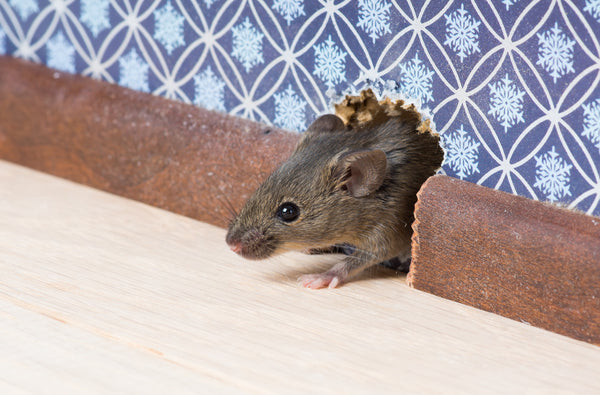No one can deny the invigorating, cooling and calming effects of peppermint essential oil! Native to Europe, peppermint is one of the oldest herbs used for medicinal purposes historically. Hailing from the lavender and rosemary family, peppermint is a hybrid of watermint and spearmint and the oil is extracted through the process of steam distillation from the leaves and topmost flowers of the plant.
Peppermint essential oil is a natural antibacterial, antiviral, anti-fungal and analgesic (pain reliever) and is an excellent anti-parasitic. Used by cultures all over the world for its powerful medicinal properties, modern research today attributes these qualities to menthone, menthyl esters, and most importantly to the active compound, menthol, which is found in high concentrations in peppermint oil. Peppermint oil is used widely in the manufacturing of products we use daily such as shampoo, chewing gum, toothpaste, ice cream, soap, tea and more.
Here are some top peppermint oil benefits:
- Alleviates stomach pain
- Relieves digestive issues
- Inhibits bad breath
- Suppresses headaches
- Natural antibacterial
- Excellent insecticidal
- Brings clarity and mental focus
- Soothes respiratory problems
- Energy booster
- Loosens sore muscles
- Stress reliever
- Powerful and affordable alternative to prescription drugs
Suitable for literally any condition from relieving digestive issues, indigestion and nausea to alleviating sinus infections, soothing muscle cramps and getting rid of bad breath and pests, there are countless reasons why peppermint essential oil should be a staple in your medicine cabinet!
Here are top 35 remarkable peppermint oil uses and benefits:
Peppermint Oil for Digestion

Traditionally and even today, peppermint oil is most widely known to be a powerful soothing digestive aid. Studies suggest that the potent active ingredient in peppermint oil, menthol, helps to calm spasms in the muscles which helps alleviate nausea, indigestion, bloating and IBS symptoms.
1. Peppermint Oil for Nausea
A 2013 study found that peppermint oil helped to reduce chemotherapy-induced nausea, and stated that peppermint essential oil, known scientifically as Mentha Piperita, was not only safe and significantly reduced nausea and vomiting in patients but is also a cost-effective solution for dealing with nausea that affects 70-80% of cancer patients.
How to use peppermint essential oil for nausea:
1. Apply Topically: Mix 1-2 drops of peppermint oil with the same amount of a carrier oil such as coconut oil or jojoba oil and rub it behind your ears.
2. Use in a diffuser: The slow, constant aroma can help subside the feeling of nausea
3. Inhale directly: When you're feeling nauseous or have motion sickness, inhale peppermint oil deeply, directly from the bottle. You can also apply 1 drop to each wrist.
2. Peppermint Oil for Heartburn and Stomach Ache
Peppermint oil can calm the gastrointestinal tract muscles and also stimulate the flow of bile, which helps break down fats and pass food through the gut more efficiently. This makes it a helpful remedy for acid reflux and calming an upset stomach. The oil also provides cooling, soothing relief for heartburn.
Note: Peppermint oil can relax the sphincter muscle which divides the stomach from the esophagus so if you have gastro-esophageal reflux disease, or GERD, this could possibly worsen your heartburn.
How to use peppermint essential oil for heartburn and upset stomach:
1. Apply Topically: Mix 2-3 drops of peppermint oil with 1 tsp of a carrier oil such as coconut oil and massage on your stomach.
2. Take internally: In a glass of warm water add 1 drop of peppermint oil (a little goes a long way!), 1/2 tsp of apple cider vinegar and 1 tsp of honey. Mix and drink.
3. Peppermint Oil for Gas and Indigestion
Peppermint has been used for centuries to soothe indigestion and bloating, and there's good reason for that. Peppermint oil is a natural carminative, meaning it helps to relieve flatulence from the stomach and the intestines by relaxing abdominal and intestinal muscles and calming spasms in the colon. This helps to ease cramping and decrease bloating and gas, helping to alleviate stomach aches.
How to use peppermint essential oil for gas and indigestion:
1. Apply Topically: Mix 2-3 drops of peppermint oil with 1 tsp of a carrier oil such as olive oil and massage on your stomach.
2. Take internally: In a glass of warm water add 1 drop of peppermint oil and 1 tsp of honey. Mix and drink before meals.
4. Peppermint Oil for IBS (Irritable Bowel Syndrome)
Irritable bowel syndrome or IBS affects primarily women, and causes pain and discomfort in the belly with bloating, diarrhea and constipation. A 2007 study documented that peppermint oil taken internally in capsule form effectively relieved IBS symptoms by half in 75% of patients who used the treatment over a month. This makes peppermint essential oil an excellent natural, affordable alternative to costly prescription drugs with adverse side effects.
A more recent 2014 study suggested that peppermint oil is "significantly superior to placebo for global improvement of IBS symptoms," and it concluded by stating that peppermint essential oil is a "safe and effective short-term treatment" for Irritable Bowel Syndrome.
Peppermint Oil for Colds, Cough and Flu

When you have the cold and flu, you've most probably reached for an over-the counter remedy that provides relief from blocked nasal passages, sore throats and chest congestion. More often than not, these products contain peppermint oil with its active cooling and soothing ingredient, menthol. And there's a reason why menthol is present in sore throat sprays and lozenges and chest rubs - drug manufacturers know it works!
5. Peppermint Oil for Sore Throat
Menthol can help cool and numb a sore throat, providing much needed relief. Peppermint oil's analgesic properties help to alleviate pain caused by a sore throat. It's natural anti-bacterial properties fight throat infections and it's anti-inflammatory properties help to reduce swelling.
How to use peppermint essential oil for sore throat pain:
Sore Throat Gargle: Mix 1-2 drops of peppermint oil in a glass of warm water. Gargle with the blend to reduce throat inflammation, kill bacteria and numb the pain. You can also add 1/2 a tsp of natural rock salt for added benefit.
6. Peppermint Oil for Colds
As a natural anti-bacterial and anti-inflammatory menthol is very effective when it comes to treating cold and flu symptoms such as congestion, sinus infections and bronchitis. Peppermint oil acts as a natural decongestant and helps to thin mucus relieving nasal congestion.
How to use peppermint essential oil for colds:
1. Inhale Directly: Simply taking a deep whiff of peppermint essential oil from the bottle can be enough to open up the airways - and invigorate the senses!
2. Apply Topically: Mix 2-3 drops of peppermint oil with a carrier oil such as coconut or olive oil and massage on the chest to relieve congestion.
3. Steam Inhalation: Add 8-10 drops of peppermint essential oil to a bowl of boiling water, place a towel over your head and inhale the strong vapors for 5-10 minutes. The hot steam helps to thin and drain mucus in the airways and the decongestant properties of peppermint help to relieve cold and congestion symptoms.
4. Use in a Diffuser: Add 5 drops of peppermint oil and 5 drops of eucalyptus essential oil in your diffuser. Breathe in the medicinal vapors from both these powerful essential oils all night long.
7. Peppermint Oil for Cough
Peppermint oil's decongestant properties help in clearing your chest congestion by thinning mucus and making your cough more productive. The all natural healing balm recipe below combines peppermint and eucalyptus oil (an excellent anti-inflammatory, proven to help with chronic bronchitis). This rub helps in loosening mucus, so that when you cough, the loose mucus can be expelled out of your chest. It's also a safe alternative to over-the-counter menthol chest rubs that contain harsh chemicals.
Peppermint oil healing balm for cough and congestion:
- 1/2 cup coconut oil or olive oil
- 2 tablespoons of beeswax pastilles (or grated beeswax)
- 15 drops of Peppermint Oil (contains the active ingredient Menthol, which opens up nasal airways)
- 20 drops of Eucalyptus Oil (contains the active ingredient Eucalyptol, which is a natural cough suppressant)
Melt beeswax and carrier oil over a double boiler. Add the essential oils. Stir and pour in a container (small tins or a small glass container is best) and let set. Once set, apply to the chest and below the feet. Store in a cool dry area. Repeat as needed.
8. Peppermint Oil for Sinus
There's nothing more discomforting than the clogged, stuffy feeling of sinus congestion when you're down with the flu. If your head feels heavy and you're having trouble breathing, reach for peppermint oil. Peppermint essential oil helps reduce inflammation, thins mucous in the sinus cavities and opens up blocked sinus airways.
How to use peppermint essential oil for sinus congestion:
1. Steam Inhalation: Add 5 drops of peppermint essential oil and 5 drops of eucalyptus oil to a bowl of boiling water. Put a towel over your head and inhale the hot medicinal steam for 5-10 minutes or until the steam dies down. The healing properties of both oils help to thin mucus and drain the nasal passages. Blow your nose as needed to expel mucus and feel relief. Repeat every 3-4 hours.
2. Add to Your Humidifier: Most sinusitis experts agree that adding humidity to the air is good for sinus sufferers. The next time you use your humidifier, add a few drops of peppermint oil. This can provide added benefit to open up the lungs and clear sinus congestion.
Peppermint Oil for Infants and Children

Peppermint oil can relieve colic and teething problems in babies, and can help relieve fever and congestion in infants and children. It is a safe, natural and affordable alternative to prescription drugs and over-the-counter products with artificial ingredients.
9. Peppermint Oil for Colic
When your baby cries uncontrollably and whatever you do does not seem to soothe, then there's a good chance your baby is colic. Colic is usually defined by the crying lasting for more than 3 weeks, for over 3 hours every day at least 3 days a week. It also gets worse during evening hours and is more likely to occur the same time every day. Peppermint oil has antispasmodic properties which calms intestinal and colon spasms and releases gas trapped in the abdomen.
A 2012 study concluded that peppermint essential oil was as effective as the drug Simethicone for relieving infantile colic symptoms. It concluded that, "all mothers reported decrease of frequency and duration of the episodes of infantile colic."
How to use peppermint essential oil for colic:
Apply Topically: Mix 1-2 drops of peppermint oil with 1 tsp of a carrier oil such as jojoba, olive, or coconut oil and massage on the baby's stomach and chest. You can apply this blend right after giving the baby a warm bath and then put the baby to sleep. Repeat every night.
10. Peppermint Oil for Teething
Teething can cause a lot of pain and discomfort in infants. Peppermint oil is an excellent natural pain reliever and can provide cooling, numbing relief, and best of all it is all-natural with no chemicals.
How to use peppermint essential oil for teething:
Natural Gum Rub: Blend 1 drop of peppermint oil with 1 drop of coconut or olive oil and rub and massage the gum area.
11. Peppermint Oil for Congestion
When your little one is down with cold and congestion don't reach for over-the-counter menthol rubs that contain artificial ingredients and might do more harm than good. Try this easy remedy below to naturally relieve cold symptoms in children.
How to use peppermint essential oil for congestion in children:
Apply Topically: Mix 1-2 drops of peppermint oil with 1 tsp of a carrier oil such as jojoba, olive, or coconut oil and massage on to the chest and under the feet. The skin on the feet is less sensitive and less likely to react to "hot" oils, and since the pores on the feet are wider than elsewhere on the body, rubbing essential oils under the feet allow for faster absorption into the bloodstream!
12. Peppermint Oil for Reducing Fever
The cooling effects of menthol does more than just soothe throat pain or freshen breath. It's also great to bring down a fever in kids.
How to treat and reduce fever with peppermint essential oil:
Apply Topically: Mix 2-3 drops of peppermint oil with a carrier oil such as coconut or olive oil and rub on a child's neck and under the soles of their feet to break a fever. Rubbing it under their feet will help it to absorb quickly and reduce body temperature.
Note: Since peppermint oil is a "hot" oil always mix it with a carrier oil like coconut oil or olive oil when using on children. If a fever goes over 103 degrees, please consult a doctor and seek medical attention.
Peppermint Oil for Pain

As a natural analgesic (pain reliever) peppermint oil can help to alleviate joint pain such as back pain, neck pain, knee pain and more and also help to relax sore, aching muscles. Due to menthol's cooling effect, the oil helps to numb the painful area and it's anti-inflammatory properties help to relieve inflammation in the joints.
13. Peppermint Oil for Joint Pain
Apart from being an analgesic, peppermint oil has an anesthetic effect that helps to soothe both the inflammation and the pain associated with joint pain caused by conditions such as rheumatoid arthritis and osteoarthritis. It is a safe, natural alternative to use for joint pain such as knee pain, back pain and neck pain than over-the-counter topical pain reliever gels that are ridden with chemicals.
How to use peppermint oil for joint pain and arthritis:
1. Apply Topically: Warm approximately 2 tbsp of coconut oil or olive oil and add 8-10 drops of peppermint oil. Rub into the affected joints. Use as needed.
2. Massage Blend: Combined with eucalyptus oil (an excellent analgesic) you can try this more potent arthritic pain relief salve.
- 8-10 drops peppermint oil
- 8-10 drops eucalyptus oil
- 1 to 1 1/2 tablespoons carrier oil, such as coconut oil or moringa oil (Moringa oil is a powerful anti-inflammatory as supported by this study making it a great choice for this blend).
14. Peppermint Oil for Muscle Pain
If you have sore muscles after a hiking trip or a long day at work or have suffered a sports muscle injury, reach for peppermint essential oil. Menthol has the ability to relax muscles, relieve inflammation and provide numbing, cooling pain relief.
How to use peppermint oil for sore muscles:
1. Massage Oil: Combine 5-10 drops of peppermint oil to 1-2 teaspoons of a carrier oil, such as olive or moringa oil (known to have strong anti-inflammatory properties) and massage into sore muscles.
2. Hot Bath: Add 20 drops of eucalyptus oil to a hot bath along with 2 cups of Epsom salts. This pain-relieving soak relaxes sore muscles and the cooling, tingling effect alleviates aches.
15. Peppermint Oil for Headaches and Migraines
If you're prone to getting headaches or tension (stress) headaches that cause constant dull pain, research suggests that peppermint oil can help.
With its ability to reduce nausea, the oil is also an excellent choice for migraine sufferers. Manufacturers have also tapped into this by developing products that contain peppermint oil designed specifically for headache and migraine relief. But instead of running to the drug store, try this simple home remedy below the next time your head starts throbbing.
How to use peppermint oil for headaches:
Apply Topically: Mix a few drops of peppermint oil with a carrier oil such as jojoba or tamanu oil (excellent for skin) and massage into your temples and forehead and behind the neck for quick, cooling headache relief.
Peppermint Oil for Skin

Striving for healthy looking skin? As an anti-inflammatory peppermint oil is excellent for skin irritations and can be used to soothe burns, itching, rashes, acne and more. It makes a terrific addition to your everyday beauty routine for fresh-looking skin as well!
16. Peppermint Oil for Face
To achieve healthy looking skin you don't need to turn to expensive store-bought facial products. Essential oils like peppermint can do wonders for your skin and overall health. Try this easy and inexpensive recipe below for healthy, glowing facial skin!
How to use peppermint oil for face:
Facial Exfoliating Scrub: Brighten up dull skin with this easy facial scrub. In 2 tbsp olive, moringa or tamanu oil add 5 drops of peppermint oil and 1 tbsp natural fine rock salt. Blend the dry ingredients and add the oil. Mix well. Wash your face and apply this blend massaging slowly. Repeat twice a week for radiant, glowing skin!
17. Peppermint Oil for Acne
Have a pimple outbreak? Peppermint oil can help control excess oil secretions, prevent pores from clogging and manage acne from spreading. As a natural anti-inflammatory it also provides healing relief caused by inflamed acne eruptions.
How to use peppermint oil for acne:
Acne Blemishes: Mix 1 drop of peppermint oil and 1 drop of eucalyptus oil (an excellent antiseptic that kills bacteria) with 6-8 drops of water. Soak a cotton swab in the blend and apply directly on pimples. Do not get in your eyes, nose and mouth. Leave on overnight for best results.
18. Peppermint Oil for Lips
Want soft, luscious lips? Try this cooling and nourishing all-natural peppermint oil lip balm to smooth dry, cracked lips all year round!
How to use peppermint oil for lips:
- 6 tsp beeswax pastilles (or grated beeswax)
- 6 tsp shea butter
- 6 tsp coconut oil
- 20 drops peppermint essential oil
Melt all ingredients in a double boiler until melted. Add the peppermint oil. Mix and fill in lip balm tins or tubes. Cool and cover when set. Enjoy!
19. Peppermint Oil for Itching
For minor skin irritations, peppermint oil's anti-inflammatory action can come to the rescue to calm itchy, irritated skin.
How to use peppermint oil for itching:
Apply Topically: For minor skin irritations combine 1 tbsp of a carrier oil (such as moringa oil, an excellent anti-inflammatory and great for skin) with 5-7 drops of peppermint oil and apply to the affected area. For skin conditions like psoriasis and eczema you can also add 5-7 drops of sandalwood oil to accelerate skin healing.
20. Peppermint Oil for Burns
With 40% + menthol content, peppermint oil is excellent to reduce inflammation and immediately cool down the burning sensation caused by nasty oven burns, steam burns and scalds.
How to use peppermint oil for burns:
Burn-Relief Spray: In a clean 100ml atomizer spray bottle (available at health and beauty stores or on the web), add water and 20 drops of peppermint oil. Shake well and spray the area liberally.
21. Peppermint Oil for Sunburn
The cooling, analgesic properties of menthol also work well for sunburn. The oil provides cooling to the skin relieving pain and it's anti-inflammatory properties help reduce redness, swelling and inflammation of the skin.
How to use peppermint oil for sunburn:
Apply Topically: Mix a little coconut oil (helps to re-hydrate burnt skin) with a few drops of peppermint oil and apply to the affected area.
Peppermint Oil for Hair

There's nothing like the refreshing, invigorating, cooling feeling you get when you wash your hair with a store-bought "menthol" shampoo. And there's a reason manufacturers add peppermint oil to hair care products too. The oil is stimulating, and has antiseptic properties making it excellent for promoting hair growth, removing dandruff and lice while giving that tingly cool, fresh feeling that really wakes you up.
22. Peppermint Oil for Hair Growth
A 2014 study concluded that peppermint oil could be used as an "alternative medicine for hair loss in humans." This is why you'll find peppermint oil in many shampoos and other hair care products such as dandruff and baldness solutions!
Peppermint oil stimulates so it helps to rejuvenate and invigorate your hair follicles. This leads to healthier hair follicles that perform better and live longer, increasing hair growth and preventing hair thinning and hair loss.
How to use peppermint oil for hair growth:
1. Add to Your Shampoo: For every 2 cups of shampoo (16 oz) add 1 tsp of peppermint oil. Mix well and pour back into shampoo bottle. Shake well before each use to make sure the oil is well distributed.
2. Nourishing Hair Oil: Simply add a few drops of peppermint oil to 1 tbsp of coconut oil or 1 tbsp of emu oil (filled with antioxidants to accelerate hair growth!) and massage into your hair. You'll not only be promoting hair growth, but you'll be completely rejuvenated!
23. Peppermint Oil for Scalp and Dandruff
Peppermint oil is great for improving scalp health and eliminating dandruff. It stimulates to increase blood flow, promoting hair follicle longevity, and with its anti-inflammatory properties it soothes an itchy, irritated scalp, keeping dandruff at bay. Bring out the peppermint oil and try this invigorating, cooling scalp treatment below for some serious healing scalp therapy!
How to use peppermint oil for scalp health and dandruff:
Scalp Treatment Oil: Melt 2 oz (4 tbsp) of coconut oil on low heat. To it add 1 tsp vitamin E oil, 2 tsp Moringa oil (a powerful hair conditioner - get it here), 20 drops peppermint oil and 10 drops tea tree oil. Mix and let cool for 2-3 hours. Apply everyday or every alternate day to rejuvenate your scalp and get silky-smooth hair!
24. Peppermint Oil for Lice
Critters detest the smell of peppermint so peppermint oil works well for the treatment of lice, and you'll find it as the main ingredient in many lice repellent sprays available at your local drug store. To eliminate head lice try this simple but effective shampoo below that not only nourishes the hair and scalp but will keep the annoying critters out!
How to use peppermint oil for lice:
Anti-Lice Shampoo: Add 15 drops of peppermint oil to 2 tbsp of shampoo. To this add 1 tsp of neem oil (Neem oil contains the active ingredient azadirachtin, a powerful insecticide, which prevents lice from multiplying). Shampoo hair with the blend and cover your hair with a shower cap for 10 minutes. Then wash and towel dry hair. Comb hair with a nit comb.
Note: Peppermint oil is a strong oil so be cautious when using this blend with children. They should not get it into their mouth, nose or eyes.
Peppermint Oil for Oral Health

Perhaps the most common use of peppermint oil is in oral health-care products - every second toothpaste, mouthwash and breath-freshener you'll see at the pharmacy contains the active ingredient "menthol" from peppermint oil. Peppermint oil disinfects, numbs and refreshes making it excellent for dental health!
25. Peppermint Oil for Toothache
Have a toothache? Numb the pain instantly with peppermint oil. Add 1 drop of peppermint oil to a cotton swab and apply directly on the aching tooth. This not only helps to disinfect and reduce inflammation, due to the oil's antiseptic and anti-inflammatory action, but the anesthetic properties of menthol numb pain, providing much needed relief.
26. Peppermint Oil for Breath
Peppermint has been used as a natural breath-freshener for centuries. Extracted from peppermint, the oil is an easy, inexpensive but highly effective essential oil due to its anti-bacterial and antifungal properties that you can use if you suffer from halitosis (bad breath).
How to use peppermint oil for breath:
1. Add to Your Toothpaste: Add 1-2 drops of peppermint oil to a small bit of toothpaste on your toothbrush and brush well for 1-2 minutes. This will help prevent cavities and leave your mouth refreshingly clean!
2. Minty Mouthwash: Kiss bad breath goodbye with this minty-fresh mouthwash! Fill 2 cups of water in a plastic dispenser or glass bottle and add 5-6 drops of peppermint oil and 5-6 drops of tea tree oil. Shake well, swish in your mouth, gargle and spit. Repeat daily after brushing.
Peppermint Oil for Focus, Energy & Stress Relief

With its energizing strong scent, peppermint oil helps you concentrate, be attentive, and alleviates feelings of anxiety and mental stress. Revitalize your senses with peppermint essential oil!
27. Peppermint Oil for Stress Relief
Had a long stressful day? There's nothing more invigorating than the fresh scent of peppermint essential oil to wake up your senses.
How to use peppermint essential oil for stress relief and energy:
1. Inhale directly: Need a quick pick me up? Inhale peppermint oil directly from the bottle or rub a drop under your nose to feel instantly refreshed.
2. Apply Topically: Mix 3-4 drops of peppermint oil combined with a little carrier oil such as olive oil and rub the shoulders and back of the neck to feel immediately relaxed.
3. Diffuse: Boost mental focus and concentration with peppermint essential oil by adding a few drops in your diffuser and letting the cool, energizing aroma waft through the air.
4. Hot Bath: Add a few drops of peppermint oil to a hot bath for instant relaxation - also great for soothing tired muscles!
28. Peppermint Oil for ADHD and Focus
To improve concentration, focus and alertness try the two home remedies below:
1. Apply Topically: When you need to focus, or before a child's homework time, rub a drop of peppermint oil under the nose or put a drop on the tongue for an instant boost.
2. Spray: Fill a 300ml spray bottle with water and add 10-15 drops of peppermint oil. Spray on your shirt or a child's shirt as needed for focus and mental clarity.
Peppermint Oil for Pest Control

Whether you're dealing with outdoor bugs, household critters or rodents, peppermint oil's strong, potent and distinct aroma works great to get rid of them all!
29. Peppermint Oil for Fleas
Peppermint oil is a safe, natural treatment to treat parasitic infections in dogs.
How to use peppermint oil for fleas:
Tick spray: You can make this all-natural flea repellent and spray on your dog's fur every alternate day. In a 16oz. spray bottle filled with distilled water add 10 drops of peppermint oil, 10 drops of eucalyptus oil, 10 drops of tea tree oil and 10 drops of citronella essential oil. Shake gently and spray.
Note: Cats are sensitive to essential oils, so this remedy is only suggested for dogs.
30. Peppermint Oil for Insects
Have destructive bugs in your vegetable patch? Use this simple but effective all-natural insecticide around the garden and even in the house to keep annoying insects away.
How to use peppermint oil to keep the bugs away:
1. All-natural bug spray: Fill a 16 oz spray bottle half-way up with distilled or boiled water. Fill the other half with witch hazel (available at your local drug store). Add 20 drops of peppermint oil and 20 drops of oregano oil (a natural insecticide, so works great in this blend) and shake gently.
2. Keep spiders away: Small bugs like cockroaches, ants and especially spiders detest the smell of peppermint oil. Soak a few cotton balls with 3-5 drops of peppermint essential oil and place around the house, especially in nooks and crannies and doors and windows where insects can squeeze through.
31. Peppermint Oil for Mice and Rats
Did you know mice hate peppermint? The strong, potent scent of peppermint oil irritates the sensitive noses in rodents, and keeps them at bay.
How to use peppermint oil for mice and rats:
Repel Rodents: Put a few drops of peppermint oil on cotton balls and stuff them in corners of the house that you know rodents usually get through. It's also a good idea to put these in your kitchen cabinets. For the garden you can soak used tea bags with a few drops of peppermint oil and spread around your vegetable or herb patch. Replenish as needed.
Other Surprising Uses of Peppermint Oil...
32. Peppermint Oil for Weight Loss
Menthol can influence how we taste and smell food and can actually change our neurosensory perceptions. This can help to control cravings and curb overeating, leading to weight loss.
A 2008 study entitled, Effects of Peppermint Scent on Appetite Control and Caloric Intake, demonstrated that those who inhaled the oil every two hours had fewer food cravings which led to a significant reduction in calorie intake.
How to use peppermint oil for weight loss:
1. Inhale Directly: Inhale peppermint oil directly from the bottle or from a handkerchief soaked in a few drops of the oil to suppress your cravings. Do this right before a meal to stave off overeating.
2. Add to Your Diffuser: Diffuse peppermint oil when you're feeling drowsy and want to turn to food (especially the munchies) for a pick me up. You can also rub 1-2 drops of the oil on your temples and wrists. This will bring back focus and curb the craving.
33. Peppermint Oil for Allergies
If you suffer from seasonal allergies run to your medicine cabinet and grab your bottle of peppermint oil. Diffusing peppermint oil and eucalyptus oil can help relax the muscles in your airways and the anti-inflammatory action of both oils can soothe and reduce annoying allergy symptoms.
34. Peppermint Oil for Hormonal Balance
Peppermint oil may help relieve symptoms of PCOS (polycystic ovarian syndrome) by lowering androgens (such as testosterone) and may help to balance hormones.
35. Peppermint Oil for Cancer
Research suggests that menthol the active compound in peppermint oil can restrain the growth of prostate cancer. The oil also has a protective mechanism and can help prevent DNA damage and cell death caused by radiation.
Side Effects and Warnings
Essential oils are natural but powerful. Some people may develop an allergic reaction to any oil so it's always best to try a little by doing a small skin patch test on your arm or leg (never your face or neck) to make sure you don't have an adverse reaction. Peppermint essential oil is a hot oil and can cause irritation of the skin and mucus membranes so it best to mix with a carrier oil.
What to Look for When Buying Essential Oils?
When buying essential oils make sure the bottle says 100% pure essential oil, and has the proper name of the species mentioned on the label of the bottle. Example for Peppermint: (Mentha Piperita). If you see the word 'fragrance' it almost always means there are other additives.
Ideally it's always best to buy essential oils from an organic source that are labeled as "Therapeutic grade," meaning they are free of toxins and chemicals and are unfiltered and undiluted.
Also beware of genetically modified ingredients and choose Non GMO essential oils.
Last Words
There is no fixed recipe when it comes to essential oils and what might work for you might not work for someone else. Since we are all biochemically exclusive, it's best to experiment with a variety of essential oils, pay attention to your body, and find the "personal blends" that work most optimally for you.

Comments (0)
Back to Blog